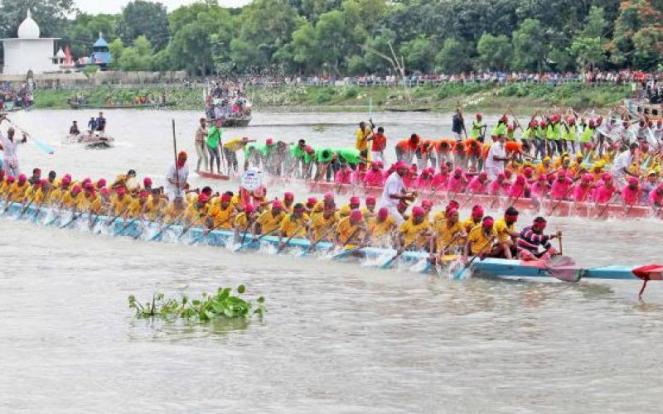May 16, 2019 SANDRP
Just as all festivities of a fisherfolk life are connected to the river, their dreams and nightmares are riverine too.
“For several days I’ve been noticing something different in the river’s flow pattern-familiar calculation just don’t seem to hold. The current where we knew it to be slanted is now straight, where we knew it to be straight is now slanted. There is no fish. The fish leaped a little away from where I laid the net, where I expected the flow. Finally, I went near the mouth of the Kurulia Canal. Found the current there turning like a top. I couldn’t sleep and all of a sudden I had this dream, Titash has gone dry.”
Rivers of the Bengal delta are fickle. Ganga-Brahmaputra-Meghna Delta is the largest delta of the world, covering an area of 105000 km2 in Bangladesh and India. (Much more by some estimates). The rivers here carry silt with origins in the ever-rising Himalayas to the Bay of Bengal. Annual silt load of the delta is more than a billion tonnes.[iv] This silt-water duality keeps the land in constant flux. Banks collapse, islands emerge, villages are eaten up by angry rivers overnight. One of the biggest issues facing rivers in Bangladesh is desiccation of rivers by siltation. Titash was no exception.
“After days of searching, the fishermen do find strange discrepancies from what they’ve always known. Malos have known this river for generations. It is their constant companion day and night. To the lanes and passageways of its mind, they have unrestricted access. Its ins and outs they know as if they could see them on the mirror of their thumbnail. Hence, from even a slight feel of the pulse of its currents, they know if a disease enters its body somewhere. They know that somewhere nearby, a very large silt bed is growing, moving closer.”
World over, riverine fishing communities are tied to their rivers and fish for generations. They are the interpreters of the maladies of the river and its creatures. In the other corner of the world, in the Yukon which flows through Canada and Alaska, Yupik natives call themselves “People of the Big River”, just like Malos are the children of the Titash. In the Mekong, myriad cultures are intermeshed with the river and the fish.
Adwaita Mallabarman’s portrayal of a desiccating, silting Titash River was not just a work of fiction but invaluable documentation of what was happening to a river and its people. Today, this collapse is documented with care and attention in places like the Yukon. Biggest dam removal in the world history is scheduled to happen at the Klamath River in the United States and one of the reasons for this is to revive traditional salmon runs in the river which provided sustenance and nourishment to native Klamath Indian tribes. In Alaska, tribes do not allow these discussions to become romanticized relics. While I reviewed the Kings of Yukon by Adam Weymouth, this really stung. The natives there have a space to say, “To many non-Indian observers, subsistence is nothing more than a cultural antique, a holdover from previous times that will disappear as market economies take over. Subsistence is not a relic from the past. It has and continues to be the foundation of Alaska Native societies.”
But in most places in the Indian subcontinent, riverine fishers saw their rivers die in front of their eyes and had no space to record this or record what they felt and went through. There was no question of a place for them in the decision-making process about the rivers, or in the Environment or Social Impact Assessments, no question of any rehabilitation or even compensation or protection of their livelihoods.
The sections of Titash Ekti Nadir Naam which deal with the growing silt bed in Titash and in a way spell doom for the Titash Malos are some of the most moving passages of the book, reflecting a dazzling insight into the workings of a river in the Bengal delta.
Mallabarman writes:
“One day the pole of Mohan’s net catches the floating silt bed. It is the last day of an ebb tide: the big river has drawn down Titash’s water level, as it always does before the tide turns and reverses its flow. During the ebb, even after giving away much water, Titash still has a deep, solemn body of water. The abundance of its midstream never diminishes. Mohan’s heart pounds.
As soon as he lowers his net, even in the midstream, its bamboo pole hits the ground at the bottom. The boat shudders. So does Mohan.”
In an environment that is constantly changing, river banks are eroded and villages are turned destitute overnight. This is reflected in several Bhatiyali songs of Bengal: songs of the river sung by lone boatmen during ebb tide.[x] Bangladesh’s National Poet Kazi Nazrul Islam, the Rebel poet wrote and composed remarkable songs on this fickle beauty. A Nazrul Geeti (Songs of Nazrul) laments:
As one riverbank is destroyed, other is built
That is the game of the river
A prince of the morning becomes a pauper by night,
That is the game of the river
On the isle of such river, you built a house, you simpleton,
And you hope for happiness?
As the river destroys, you will not reach the other shore
That is the game of the river.
Titash behaves a bit differently from these large rivers. “Titash does not erode either bank. When the silt bed started to form, it started inside, at the center of the riverbed, expanding outward and rising upward. During the rainy season, Titash is again full to the brim. At the end of it, the water level goes down and the silt bed reappears above the water like a chest that rises after a deep breath. Where has so much water gone? Where have so many fish gone? Only two narrow channels remain near the two sides of Titash, the only evidence that a brimming river once flowed here”.
With the emerging silt bed and drying Titash, the ownership of the river changes. Farmers come to literally stake their claims. “As long this land was under water, Malos moved on it, it was theirs. The moment it floats above the water, it becomes the farmers’. Farmers right is staked in solid reality, rooted in soil. And the Malos’ right was flowing water, in its formless, groundless, ever moving reality. That right never had stable support, a firm foothold. As long as there is water in the river, only that long so they float on the water, When the water dries, they too evaporate and disappear.”
After more than 50 years, these lines ring truer than ever.
India has built more than 5000 large dams across its rivers, big and small. All of these dams: whether for irrigation, or hydropower or water supply or flood control or navigation (like Farakka Barrage in West Bengal), have had a catastrophic impact on fish diversity and fisheries livelihood. And yet, fisherfolk are the weakest stakeholders in this game.
The mighty Narmada was once teeming with fish. Hoshangabad on its banks was one of the biggest landing stations for Mahseer fish in the country. Today, there is nearly no Mahseer to be found at Hoshangabad after Sardar Sarovar project of 30 Large and 135 medium projects. At one such incomplete dam, I met Mangat Ram Ji, a veteran Narmada Bachao Andolan activist and a fisherman himself. He says, “In the Narmada Valley, like in the rest of the country, fisherfolk have been the biggest losers of dam development. We talk of जमीन के बदले जमीन, मकान के बदले मकान for the landed people, but what about us fisherfolk? Can you give us नदी के बदले नदी?”
No, we cannot.
All across the country, fisherfolk have faced the brunt of dams, pollution, sand mining, encroachments, water extractions, diversions. As Krishna River became one of the most over-allocated basins in the world, Prakassam Barrage diverted almost all of its water away from the delta. The Upper Krishna estuary is dry. Fisheries productivity collapses in dry years.
In the dry Cauvery, one more contested river, mass fish deaths are a norm.
In the dry Vaigai, local fish like Ayirayi are nearly extinct.
Barrages and diversions on Ganga increased sedimentation and contributed to a collapse of fish like major carps, whose yield declined from 26.62 to 2.55 kg/ha/year during the last four decades.
In the Narmada, Sardar Sarovar Dams resulted in drying up of the entire productive estuary. Fisherfolk says, “Yield of Hilsa has drastically reduced after Sardar Sarovar Dam has been built. There has been a reduction of 65 to 70%. The overall water level of the estuary has gone down. Post monsoon the river becomes so dry that we can walk across the riverbed. This had never happened in the past before Sardar Sarovar.”
This is precisely the visual used in Titash, as the river dries up. “In the middle of the river where you can’t touch the bottom with a twenty cubit bamboo pole, a tiny fellow was walking across on dry, hard land. My heart leaped up to my mouth, my hands and feet were trembling.”
In West Bengal, where fables were written about the Hilsa fish, Farakka Barrage led to a colossal decline of the fish. When I visited Farakka Barrage and its fisherfolk in 2014, groups of fishers sat under banyan trees along the river, with nothing much to do. Some had not made a catch in the past three days.
After the rise of silt bed in the Titash, which was the best and the kindest rivers for the Titash Malos, the community starts to crumble. Youth lose pride in being Malo, elders put up no fight when farmers claim the riverbed. “When the river dried, we died. We’re not going to fight over land.” Debts start mounting. Moneylenders drag elders by their beards and make them stand in the water of Titash to confess how much money they have. “Even shivering in the wet in wintertime, standing in the waters of Titash, these men cannot utter lies; it is impossible to lie in Titash’s water even if they can lie anywhere else. Some confess they have two rupees, some say one and three-quarters, some confess they have none at all.”
Years go by, silt bed grows, Titash hardly holds water and the entire community disintegrates. Malo homes stand empty, women beg, men work as labor on other ships, some carry sacks on their backs for a couple of nickels. “But separated from waters, Malos gasp like fish.”
The novel ends as the Malo community of Titash undergoes a transition. In many senses, Adwaita Mallabarman’s book is a Parikrama of the river. There are several aspects to it: Strength of the Malo women, sisterhood and friendship which forgets alacrities in the past and embraces the present, several forms of folk music like songs of Sari, Jari, Baromashi, Bhatiyali, Haribhangsa, Naamgaan, Paalgaan, stunningly beautiful passages of a child beholding a river: as a moving sky sometimes or a wide, winding road at other times, passages of a father bathing his son on the riverbank, scrubbing him with sand, etc. Some passages make us stumble and wonder at their craft and authenticity.
No one but a son of a fisherman could write something this magical: A dream of a Maasi for her son:
“The water’s new height reaches the Malo neighborhood and announces the fullness of the river. Small fish swim upstream in the current that now surrounds Malo homes. All small fish have spawned; the babies are out and they have learned to swim upstream. Ananta could catch plenty of them in a small net right here! He could also sell them in the market.
When nobody works in the water and the Ghat is quiet, shoals are visible just below the surface, coming across the landing. So many village Ghats they must’ve crossed like this, and so many others they will cross in the coming days, going over obstacles that must be mountains for them; Where do they go? Where will they come to rest? Who knows where their journey will end? But they are determined to move on. If you stir the water with a plate and push a wave at them, they back up a little and move on again. If you try to grab them, they dart out a yard and resume their passage parallel to their previous course. If there are too many people in the water, bands of fish hide in pockets of submerged shrubbery and wait and wait. Small fish fear the deep water; they wait in shallow waters till bands gain in numbers, and as soon as Ghats become quiet, they proceed again. Nothing can deter them.
Subla’s wife catches a band of them by laying the end of her sari in their way. Caught there, a bunch of baby Punti flutter. Not wanting to separate them from the water, she releases them and watches the shoals of fry go by, some striped, like little girl’s saris, some transparent with a slippery coat. Ananta could catch them all with a small-meshed little net!”
Titash Ekti Nadir Naam talks about Hindus and Muslims without a hint of condescension. Given the charged times of partition, this is remarkable. Relation of Banamali and Kadir Mian is beautiful and real, not just because Banmali is a Hindu and Kadir Mian is a Muslim, but because they are children of the river, facing similar fates.
Ananta’s wonder as he sees a rainbow stretch across the sky, even when he is hungry and destitute reminds us of children of the street who wait and gasp at an airplane.
For all its tragedy and melodrama, Titash Ekti Nadir Naam is a celebration of a river and its people. Its been 63 years since its publication and things are not better either for our rivers or our fisherfolk.
Books like Titash Ekti Nadir Naam or Ichhamati are not about nostalgia. They are about remembrance. We cannot afford to forget what happened to the Malos along the banks of Titash.
Like Ritwik Ghatak says in Komal Gandhar, “Despite the pain, we must remember the traumas that forgetfulness brings about. Through remembrance, we may yet affirm our human dignity against the resonance of cruelty.
And yet, the landscape of hope is too vast. Too subtle, too tender. Just like our Bengal.”
Parineeta Dandekar (parineeta.dandekar@gmail.com)

Source: https://sandrp.in/2019/05/16/river-as-a-companion-titash-ekti-nadir-naam/




